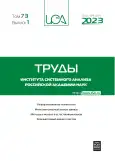Economic Cycle Prediction using Machine Learning – Russia Case Study
- Authors: Amos V.K.1, Smirnov I.V.1, Aidrous I.A.1, Asmyatullin R.R.1, Glavina S.G.1
-
Affiliations:
- Peoples Friendship University of Russia (RUDN Universiry)
- Issue: Vol 73, No 1 (2023)
- Pages: 101-109
- Section: Data Mining
- URL: https://journal-vniispk.ru/2079-0279/article/view/286880
- ID: 286880
Cite item
Full Text
Abstract
The long-term development of the world economy is characterized by cyclical development. To date, there is no single accepted approach to describe the nature of the economic cycle. Therefore, studies of economic and political cycles are one of the key areas of economic theory. Econometrics and machine learning have a common goal: to build a predictive model, for a target variable, using explanatory variables. This research aims to identify economic cycle in Russian Federation using collective factors. It uses a different approach, concerning classical econometric techniques, and shows how machine learning (ML) techniques can improve the accuracy of forecasts. We used three machine learning algorithms such as k-Nearest Neighbors (kNN), Random Forests (RF) and Support vector machines (SVM). The research is based on 30 economic factors for the period 1990-2020 from FRED, World Bank, WTO, Federal State Statistics Service, Bank of Russia etc. The results indicate that the Russian economy would be very active (peak) in the next quarters. This result could be a new approach to provide policy recommendations to authorities and financial institutions in particular.
About the authors
V. K. Amos
Peoples Friendship University of Russia (RUDN Universiry)
Author for correspondence.
Email: broukouameamos9@gmail.com
PhD student in IT, Department of Information Technologies
Russian Federation, 6 Mikluho-Maklaya St, Moscow, 117198I. V. Smirnov
Peoples Friendship University of Russia (RUDN Universiry)
Email: ivs@isa.ru
Associate Professor, Department of Information Technologies, also Head of Department No. 72, FIC “Informatics and Control” RAS, Institute for Artificial Intelligence Problems
Russian Federation, 6 Mikluho-Maklaya St, Moscow, 117198I. A. Aidrous
Peoples Friendship University of Russia (RUDN Universiry)
Email: aidrous@mail.ru
PhD. in Economics, Associate Professor at the Institute of World Economy and Business
Russian Federation, 6 Mikluho-Maklaya St, Moscow, 117198R. R. Asmyatullin
Peoples Friendship University of Russia (RUDN Universiry)
Email: rav.asmyatullin@gmail.com
PhD. in Economics, Associate Professor at the Institute of World Economy and Business
Russian Federation, 6 Mikluho-Maklaya St, Moscow, 117198S. G. Glavina
Peoples Friendship University of Russia (RUDN Universiry)
Email: sofiya.glavina@gmail.com
PhD. in Economics, Head of the Digital Economy Programme at the Institute of World Economy and Business
Russian Federation, 6 Mikluho-Maklaya St, Moscow, 117198References
- Dalibor, S. : Prévision macroéconomique dans l’ère des données massive et de l’apprentissage automatique.
- M. Khichane : Le machine Learning par la pratique. Edition ENI
- Chaiboonsri, Chukiat Wannapan, Satawat. (2019). Big Data and Machine Learning for Economic Cycle Prediction: Application of Thailand’s Economy. https://doi.org/10.1007/978-3-030-14815-7_29.
- Pontius, R.G. and Millones, M. (2011) Death to Kappa: Birth of Quantity Disagreement and Allocation Disagreement for Accuracy Assessment. International Journal of Remote sensing, 32, 44074429.
- Cortes, C. and V. Vapnik, Support-vector networks. Machine learning, 1995. 20(3): p. 273-297.
- Raikwal, J. and K. Saxena, Performance evaluation of SVM and k-nearest neighbor algorithm over medical data set. International Journal of Computer Applications, 2012. 50(14).
- Abdi, M.J. and D. Giveki, Automatic detection of erythemato-squamous diseases using PSO–SVM based on association rules. Engineering Applications of Artificial Intelligence, 2013. 26(1): p. 603-608.
- Ministry of finance of Russian federation: http:// minfin.gouv.ru
- Wannapan, S., Chaiboonsri, C., Sriboonchitta, S : Prévision macro-économétrique pendant les périodes du cycle économique à l’aide d’un algorithme bayésien d’optimisation des valeurs extrêmes. Dans : Kreinovich, V., Sriboonchitta, S., Chakpitak, N. (eds.) TES 2018. SCI, vol. 753, p. 706 à 723. Springer, Cham (2018).
- Chakraborty, C., Joseph, A. : L’apprentissage automatique dans les banques centrales. Document de travail n° 647 des services de la Commission. Banque d’Angleterre (2017).
- Bholat, D.: Big data and central banks. Q. Bull. Q1, pp. 86-93 (2015). https://www.researchgate. net/publication/276101527_Big_Data_and_central_banks
- Chakraborty, C., Joseph, A.: Machine learning at central banks. Stuff Working Paper No 647. Bank of England (2017).
- Hinge, D.: Big Data in Central Banks. Published by Infopro Digital services Ltd. Central Banking Publications, London (2017).
- Signorini, L.F. Harnessing big data machine learning technologies for central banks. The Printing and Publishing Division, Bank of Italy, Rome (2018).
- Coulombe, Philippe Leroux, Maxime Stevanovic, Dalibor Surprenant, Stéphane. (2020). How is Machine Learning Useful for Macroeconomic Forecasting?
- Lahiri, S.N. (2003). Resampling Methods for Dependent Data. Springer.
- Rafinot, Thomas. (2017). Asset Allocation, Economic Cycles and Machine Learning.
- Hull, Isaiah. (2021). Machine Learning and Economics. https://doi.org/10.1007/978-1-48426373-0_2.
- Statistics, L.B. Breiman, L. (2001). Random forests. Machine Learning. 5-32.
- Ayres, Robert. (2020). Economic Cycles, in Principle. https://doi.org/10.1007/978-3-030-396510_16.
Supplementary files









